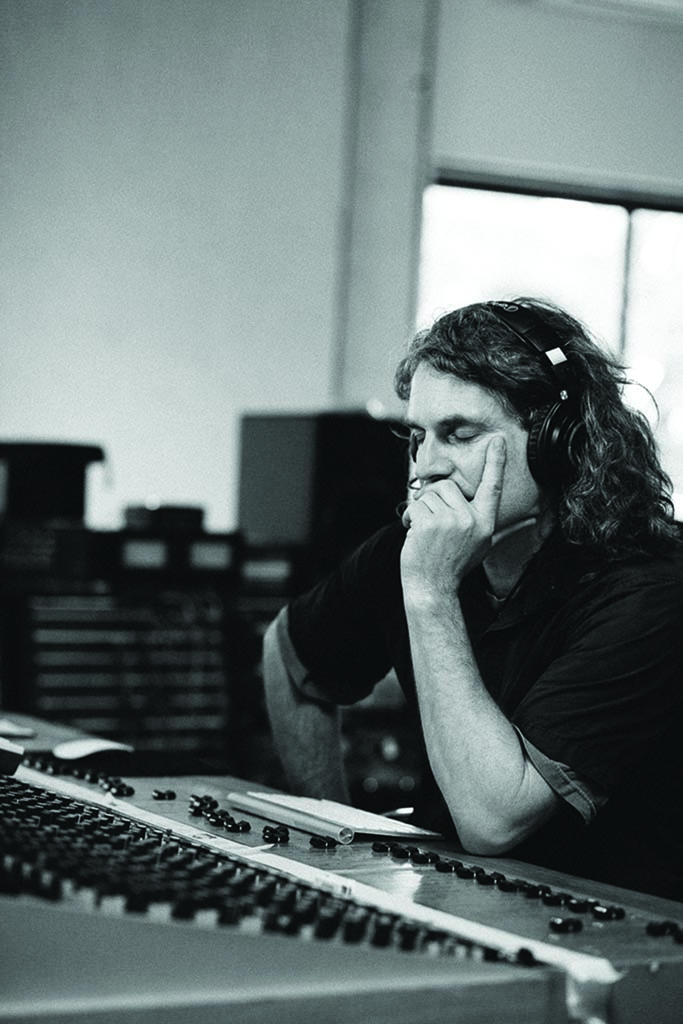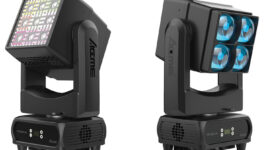LISTEN HERE
14 Aug 2023
THE PARADIGM SHIFT

Subscribe to CX E-News
There hasn’t been a paradigm shift in the audio industry for a couple of decades or more, by my reckoning. The wholesale adoption of all things digital marked the last significant shift in our industry, and since then the changes have been evolutionary rather than revolutionary. But that time is passing. We’re now on the cusp of the greatest technological shift in recent memory.
It’s a big call, foolhardy even, predicting a seismic shift in any industry, let alone the audio industry, which generally advances like an agitated eight-armed octopus rather than a single homogeneous mass. Each of us has our own perspective from the vantage point of whichever arm we flail upon, about the various ways technology has impacted our industry. From my arm in the recording industry, specifically (with occasional views from FOH), I’ve mostly witnessed us traveling around in concentric circles in recent decades, rather than forging ahead, particularly with respect to audio resolutions.
While visual industries were advancing headlong into hi-res formats of every description some years ago now, bringing along with them millions of customers who quickly left their old CRT screens on the roadside, the audio industry was regressing into the world of MP3 formats, vinyl, and tape. Three dead or dying formats, all of them inferior to the resolution at which I recorded, mixed and mastered, were cynically being touted as the next big thing, in one case by a huge multinational with a vested interest – thanks Apple.
This, of course, was rubbish. We weren’t advancing at all. But the world swallowed it nonetheless and we were left to stagnate in a retrograde technological cycle from which we are yet to fully extricate ourselves.
But in this century at least, particularly from a recording engineer’s perspective, things have evolved quietly in a manageable way, there’s no doubting that. And in some respects, many would agree that technological evolution is by far the preferred pace at which change should occur anyway. Paradigm shifts are usually synonymous with job loss, prohibitive cost blowouts for professionals, plummeting values of equipment we already own, and a general unease around the prospect of having to invest in new technology that may ultimately prove a long-term failure. The latest of these has arguably been Atmos or Immersive Audio: choose your own terminology there.
The only winners in any significant technological paradigm shift tend to be manufacturers and resellers, all of whom are generally keen for wholesale change to occur, particularly if it sweeps away, and renders valueless, old technology.
And a shift is coming, or perhaps already has. It is, of course, AI.
This innocuous two-letter abbreviation has finally reached the inboxes of most of us by now, though how this technology might directly affect us all remains far less clear. But affect us it will.
AI is set to career into us like a bowling ball down a slippery alley. Some of us in our ten- pin staggered formation still seem blissfully unaware of the impending strike, but from my vantage point somewhere on the outside of this hapless triangle, it appears to be coming towards us at a rate of knots.
The only question now is whether AI’s impact will score a strike that knocks us all for six, or spares a few of us… for the second ball, at least.
To assert that AI may only affect the audio industry to a lesser extent, if at all, is to grossly overstate our industry’s autonomy in the grand scheme of technological advancement. We are not at the cutting-edge of technological development; in the audio industry, we adopt, repurpose, and modify it to suit our needs.
AI is barrelling towards us, has already impacted several of the ways we go about our work, and its early adopters have already sent shockwaves through the industry about what’s possible, what’s probable, and just how destabilising the technology might ultimately be.
The paradigm shift is here, today, writing its own code as we speak and acting autonomously, if only to prove one point: that we really don’t know where this leads us, how it might benefit us and what the downsides, which are potentially considerable, truly are. But make no mistake: these changes will affect us, our children, and from there… who knows.
And if I’m wrong, awesome.
The Eagle Has Landed
Let’s take a side-step for a moment though shall we, draw breath, and consider a few facts that have already been borne out by recent events.
AI technology is already being used to synthesise voices in every corner of the world where a human voice was previously utilised in communication. In the music industry more specifically, there have already been many examples of songs written with AI, lyrically and musically, which have then been ‘sung’ by a famous artist, though of course, it’s not them, but rather a synthesised facsimile rendered by a computer. Some of these songs have already been viewed in their millions on YouTube and are convincing in their vocal mimicry; some of the comments from listeners alongside which have been statements like: “It sounds like Drake, only better!”
So here already we have a scenario where a song that is popular online has had no human featured as the singer, songwriter, or arranger. Worse still, it has brought into legal question the very notion of who owns the sound of an individual’s voice; a conceptual question for which the answer was, up until recently, self- evident.
What does this single scenario alone mean for our industry: for artists, songwriters, singers, record labels, publicists, recording engineers? Already people are using AI to build virtual entertainers from the ground up using algorithms alone. This might seem kooky for now, or nothing more than a marketing exercise to some. But it’s real, and it’s advancing faster than Usain Bolt. There’s currently no regulation around it in our industry or any other, and by the time governments have moved glacially to limit AI’s impact, ‘Usain’ will have done several celebratory laps around the arena.
A Future Not Written – Yet
The way AI technology is used today, tomorrow, or decades from now is unknowable. Even when we limit our projections to a much shorter timeline, looking forward only a year or two from now, things still seem murky at best. Perhaps a couple of years from now, if vocalists become a threatened species (which I doubt will happen), microphones and preamps will become redundant in all but certain pockets of the audio industry. This may seem fanciful, but it is possible. Maybe new AI artists will become so popular that they’ll start to dominate the ‘live’ scene, at which point touring companies and venues will be free to dispense with mics, foldback, consoles and even in-ears, since no-one on stage has any. Ears, that is.
And in 10 or 20 years will there be AI robots in the security pit at concerts? Dunno.
AI’s Massive Upside
In the same way AI is having a powerful, positive impact in fields such as medicine and transportation, the audio industry is set to reap huge benefits from this gargantuan leap in technological advancement.
Within the next year or two there are likely to be massive advancements in all corners of the audio industry: from sound restoration, noise reduction, and noise-cancellation tools, to exponential improvements in everything from compression, gating, effects generation and feedback control, dynamic EQ, mix visualisation technology, immersive audio, and of course manufacturing standards, both digital and physical.
Very soon there will be advanced tools at our disposal to perform tasks around countless audio control methods, particularly those requiring endless, real-time dynamic parameter shifts, like multiband compression, equalisation and feedback management, to name but a few. These will contribute massively to the way we go about our daily routines in various roles within the industry.
From a personal perspective, I’m very much looking forward to spending far less time in the studio de-clicking audio files, labouring over the removal of spurious noises, and managing the settings of four compressors simultaneously in a signal chain of a dynamic vocal recording. I won’t pine for the days when distortion was basically impossible to remove from a blown-out audio signal nor bemoan my loss of autonomy around having to manually concoct 40 decent crossfade points between countless takes of a single overdub.
Live, in situations where a lead singer simply doesn’t know how to project into a microphone, but also insists on having the loudest foldback known to man, I’ll enjoy AI’s tireless assistance in helping to prevent vibe- shattering, unpredictable feedback. Having more time to advance the tone and depth of a live mix, rather than merely trouble-shoot technical dramas or sweat over gain before feedback, will help lower my stress levels and possibly even free me up to enjoy the show!
But will AI get so good at any or all of these roles that I will eventually be made redundant? Inevitably, some of the tasks we currently perform in our various roles in the audio industry will be thrown on the scrap heap soon enough. But this won’t mark the end of our careers. On the contrary, it will signal a new, exciting beginning where many of the things we have always wished we could achieve in our fields of expertise, will suddenly become possible. That is an exciting prospect.

Andy Stewart owns and operates The Mill studio in Victoria, a world-class production, mixing and
mastering facility. He’s happy to respond to any pleas for pro audio help. Contact him at andy@themill.net.au or visit www.themillstudio.com.au
Subscribe
Published monthly since 1991, our famous AV industry magazine is free for download or pay for print. Subscribers also receive CX News, our free weekly email with the latest industry news and jobs.






